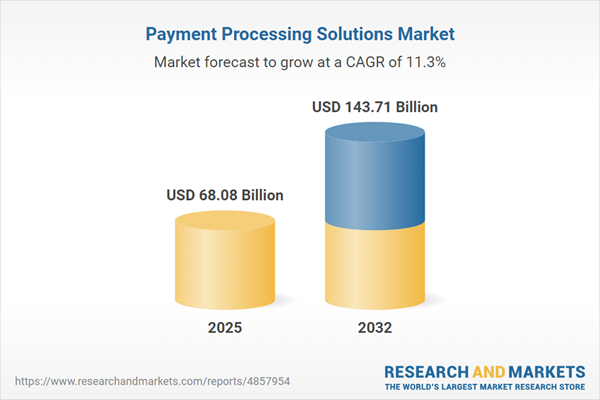Speak directly to the analyst to clarify any post sales queries you may have.
The Payment Processing Solutions Market is rapidly transforming as enterprises worldwide adapt to evolving technology, regulatory pressures, and the growing need for secure, seamless transaction experiences. Senior decision-makers face heightened complexity as they drive modernization and compliance in dynamic commercial landscapes.
Market Snapshot: Payment Processing Solutions Market Growth & Outlook
The Payment Processing Solutions Market demonstrated robust momentum, expanding from USD 61.17 billion in 2024 to USD 68.08 billion in 2025, with forecasts pointing to a compounded annual growth rate of 11.26% and an expected market value of USD 143.71 billion by 2032. This sustained growth reflects rising enterprise investments in scalable, cloud-driven payment solutions designed to enable omnichannel commerce and support digital integration. The increasing adoption of digital wallets and flexible payment platforms is compelling organizations to reassess technology stacks, compliance strategies, and operating models. As payment solutions anchor digital business infrastructure, adaptability, reliable security, and frictionless transaction flows have become essential for enterprises across all sectors.
Scope & Segmentation of the Payment Processing Solutions Market
This report delivers a detailed analysis of strategic dimensions, offering clarity on the evolving risks and opportunities for providers and enterprise users. Key aspects shaping the competitive landscape include:
- Payment Modes: Bank transfers, credit cards, debit cards, and electronic wallets facilitate diverse omnichannel and device-agnostic payment journeys for both B2B and B2C segments.
- Component Offerings: Managed and professional services align with hardware—such as contactless terminals and POS devices—and software designed to optimize front-end and back-end operations.
- Deployment Preferences: Public, private, and hybrid clouds, as well as traditional on-premises setups, help organizations address regulatory obligations while maintaining agility in processing payments efficiently.
- Organization Size: Enterprises of varying scale, from large corporations to SMEs, prioritize scalable, adaptive solutions to manage cost, growth, and compliance requirements.
- End-Use Industry: Banking, government, retail, healthcare, and transportation organizations drive requirements that affect payment workflows and technology integrations, influencing both innovation and compliance.
- Geographical Coverage: Americas, Europe, Middle East & Africa, and Asia-Pacific regions showcase distinct payment preferences, regulatory climates, and digital readiness, affecting solution deployment and strategy.
- Technological Enablers: Cloud computing, AI, real-time analytics, decentralized ledgers, modular APIs, and advanced cybersecurity accelerate automation, fraud detection, and seamless integration across payment ecosystems.
Key Takeaways for Senior Decision-Makers
- Payment processing systems are integral to digital transformation, supporting streamlined operations and enhancing overall customer experience through unified commerce strategies.
- Advanced analytics and artificial intelligence drive automation, strengthening risk controls while enabling actionable insights from transaction data.
- Expanding use of alternative payment channels raises user expectations. Flexible APIs and modular designs help enterprises deliver preferred payment experiences and maintain operational agility.
- Stringent regulations around open banking and data privacy incentivize the adoption of adaptable and compliant payment architectures, ensuring organizations remain responsive to changing requirements.
- Integrating value-added services such as loyalty rewards, real-time financing, and collaborative partnerships reinforces competitive positioning and deepens customer engagement over the long term.
Tariff Impact: Navigating Cost Pressures and Supply Chain Strategies
Recent changes to U.S. tariffs have contributed to rising hardware costs and reshaped investments in payment processing infrastructure. Organizations are mitigating these effects by diversifying supplier bases, seeking alternative sourcing, and evaluating near-shoring options to reduce disruptions. Transitioning to cloud-native and subscription-based models also offers a buffer against ongoing market volatility and supports business continuity amid shifting trade conditions.
Methodology & Data Sources
This analysis is informed by structured interviews with industry, regulatory, and technology leaders, as well as in-depth surveys capturing operational and investment priorities. Extensive secondary research, sector-specific reports, and official regulatory filings underpin the findings, ensuring actionable insights for decision-making.
Why This Report Matters
- Segment the payment processing ecosystem with precision to support investment strategies and partnership evaluation in a fast-evolving digital commerce environment.
- Benchmark approaches against market leaders to strengthen resilience, operational efficiency, and compliance in response to technology and regulatory shifts.
- Apply targeted, data-driven insights to enhance growth prospects, risk management, and process optimization across the enterprise.
Conclusion
As market dynamics and regulatory frameworks shift, organizations must continually adapt their payment solutions to keep pace with customer expectations and emerging technologies. This report provides the clarity needed to build robust, future-ready payment capabilities and maintain operational excellence as the industry evolves.
Additional Product Information:
- Purchase of this report includes 1 year online access with quarterly updates.
- This report can be updated on request. Please contact our Customer Experience team using the Ask a Question widget on our website.
Table of Contents
3. Executive Summary
4. Market Overview
7. Cumulative Impact of Artificial Intelligence 2025
List of Figures
Samples

LOADING...
Companies Mentioned
The key companies profiled in this Payment Processing Solutions market report include:- Visa Inc.
- Mastercard Incorporated
- PayPal Holdings, Inc.
- Fidelity National Information Services, Inc.
- Fiserv, Inc.
- Global Payments Inc.
- Adyen N.V.
- Block, Inc.
- Worldline SA
- ACI Worldwide, Inc.
Table Information
| Report Attribute | Details |
|---|---|
| No. of Pages | 187 |
| Published | October 2025 |
| Forecast Period | 2025 - 2032 |
| Estimated Market Value ( USD | $ 68.08 Billion |
| Forecasted Market Value ( USD | $ 143.71 Billion |
| Compound Annual Growth Rate | 11.2% |
| Regions Covered | Global |
| No. of Companies Mentioned | 11 |









